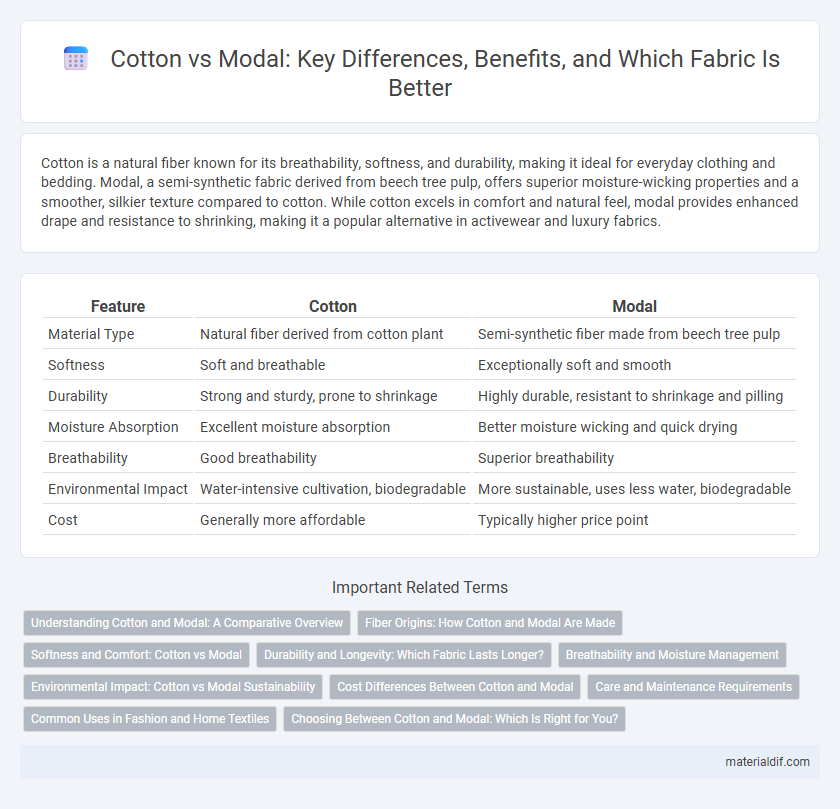Cotton is a natural fiber known for its breathability, softness, and durability, making it ideal for everyday clothing and bedding. Modal, a semi-synthetic fabric derived from beech tree pulp, offers superior moisture-wicking properties and a smoother, silkier texture compared to cotton. While cotton excels in comfort and natural feel, modal provides enhanced drape and resistance to shrinking, making it a popular alternative in activewear and luxury fabrics.
Table of Comparison
| Feature | Cotton | Modal |
|---|---|---|
| Material Type | Natural fiber derived from cotton plant | Semi-synthetic fiber made from beech tree pulp |
| Softness | Soft and breathable | Exceptionally soft and smooth |
| Durability | Strong and sturdy, prone to shrinkage | Highly durable, resistant to shrinkage and pilling |
| Moisture Absorption | Excellent moisture absorption | Better moisture wicking and quick drying |
| Breathability | Good breathability | Superior breathability |
| Environmental Impact | Water-intensive cultivation, biodegradable | More sustainable, uses less water, biodegradable |
| Cost | Generally more affordable | Typically higher price point |
Understanding Cotton and Modal: A Comparative Overview
Cotton is a natural fiber harvested from the cotton plant, known for its breathability, softness, and moisture absorption, making it ideal for everyday apparel and bedding. Modal, a semi-synthetic fiber derived from beech tree pulp, offers greater elasticity, higher durability, and superior resistance to shrinkage compared to cotton. While cotton excels in natural comfort and biodegradability, modal stands out for its smooth texture and enhanced color retention in textiles.
Fiber Origins: How Cotton and Modal Are Made
Cotton is a natural fiber harvested from the seed hairs of the cotton plant, known for its breathability and softness. Modal, derived from beech tree pulp, undergoes a chemical process to transform wood cellulose into a smooth, semi-synthetic fiber. The organic origin of cotton contrasts with modal's regenerated cellulose composition, influencing their texture, durability, and environmental footprint.
Softness and Comfort: Cotton vs Modal
Cotton offers natural breathability and softness, making it ideal for sensitive skin and everyday comfort. Modal, a semi-synthetic fabric derived from beech trees, provides a silkier, smoother feel with enhanced moisture-wicking properties, resulting in superior softness and comfort. While cotton excels in durability, modal outperforms cotton in softness and drape, ensuring a luxurious wearing experience.
Durability and Longevity: Which Fabric Lasts Longer?
Cotton is known for its natural strength and durability, maintaining fabric integrity through repeated washes and wear over time. Modal, made from beech tree pulp, offers a softer feel but tends to weaken faster with frequent laundering, affecting its longevity. When comparing durability, cotton generally outlasts modal, making it a preferred choice for long-lasting textiles.
Breathability and Moisture Management
Cotton offers superior breathability due to its natural fiber structure, allowing air to circulate and keep the skin cool and dry. Modal, a type of semi-synthetic rayon made from beech tree pulp, excels in moisture management by absorbing and wicking away sweat more efficiently than cotton. While both fabrics provide comfort, modal's enhanced moisture-wicking properties make it ideal for activewear, whereas cotton is favored for its natural ventilation and softness.
Environmental Impact: Cotton vs Modal Sustainability
Cotton cultivation demands significant water usage, often leading to water depletion and soil degradation, whereas modal, derived from beech trees, is produced through a more sustainable process with lower water consumption and reduced environmental strain. Modal fibers are biodegradable and sourced from renewable wood pulp, benefiting forest management practices that promote regeneration and biodiversity. Despite cotton's natural origin, its intensive pesticide application and land use make modal a more eco-friendly choice in sustainable textile production.
Cost Differences Between Cotton and Modal
Cotton generally costs less than modal due to its widespread availability and established agricultural production, with prices influenced by factors like climate and labor. Modal, a semi-synthetic fiber made from beech tree pulp, involves a more complex manufacturing process that increases its price compared to natural cotton. The higher cost of modal reflects its durability and softness, making it a premium option relative to cost-effective cotton fabrics.
Care and Maintenance Requirements
Cotton fabrics require regular washing at moderate temperatures and benefit from ironing to maintain a crisp appearance, while Modal demands gentle care with cooler wash cycles and minimal heat exposure to prevent damage. Cotton is durable and can withstand frequent laundering and higher dryer settings, whereas Modal fibers are more delicate, prone to shrinking and losing softness if mishandled. Proper care extends the lifespan of both materials, with cotton suited for everyday use and Modal requiring more attentive maintenance to preserve its silky texture.
Common Uses in Fashion and Home Textiles
Cotton is widely used in fashion for its breathability and comfort, making it ideal for T-shirts, denim, and casual wear. Modal, a type of rayon derived from beech trees, is favored for its silky texture and moisture-wicking properties, often found in lingerie, activewear, and luxury bedding. Both fibers are prevalent in home textiles, with cotton popular in towels and bedsheets due to durability, while modal enhances softness and drape in premium linens and pillowcases.
Choosing Between Cotton and Modal: Which Is Right for You?
Cotton offers breathability, durability, and natural moisture absorption, making it ideal for everyday comfort and sensitive skin. Modal, a semi-synthetic fabric made from beech tree fibers, excels in softness, wrinkle resistance, and moisture-wicking properties, enhancing performance in activewear and loungewear. Choosing between cotton and modal depends on your priorities for fabric feel, sustainability, and intended use, with cotton favored for natural fiber preferences and modal preferred for a silky texture and durability.
Cotton vs Modal Infographic

 materialdif.com
materialdif.com